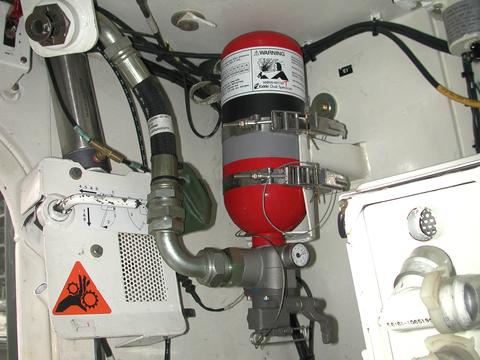
The U.S. Army uses NIST's PROFISSY computer program to help understand the performance and calculate the maximum charging pressure for this automatic fire extinguishing system, which protects the crew in an armored ground vehicle from explosive fires.
Researchers at the National Institute of Standards and Technology (NIST) have developed a new, interactive spreadsheet that will help the U.S. military extinguish aircraft and vehicle fires using the latest environmentally friendly chemicals.
While it may sound old-school, the spreadsheet is actually an upgrade of a NIST computer program that has helped protect valuable military assets and lives for several decades, despite being based on the vintage operating system MS-DOS.
Fire protection is a major issue for military vehicles, which carry flammable fluids and can incur significant damage and casualties in accidents or combat. These vehicles carry hand-held fire extinguishers among other fire-suppression systems. A challenge is filling the bottles in such a way that the heat of a fire does not boost the pressure to the point of explosion. Calculations are needed to safely combine a fire suppressant agent with the nitrogen that expels and disperses the chemical. Another challenge is what agent to use. Efforts are underway to identify fire suppression agents with low or no global warming potential (GWP).
In the 1990s, NIST researchers developed a computer program for bottle-filling calculations called PROFISSY (PROperties of FIre Suppressant SYstems), which was distributed informally and has been widely used. But the old source code made it difficult to add new fluids. NIST has now replaced PROFISSY with a spreadsheet that has additional functionality and fluids and also links to NIST's REFPROP database, which contains properties of many additional chemicals and mixtures. REFPROP has been widely adopted as a standard in the refrigerants community and also contains fire suppressing agents, including environmentally preferable alternatives to halons that deplete Earth's protective ozone layer and hydrofluorocarbons that contribute to global warming.
"We've been using PROFISSY for many years to facilitate design of fire extinguishers for test and evaluation, especially with non-halon and low-GWP fire suppression agents where off-the-shelf products are not available," said Steven Hodges of the U.S. Army's Ground Vehicle Systems Center Fire Protection Team.
"PROFISSY is an invaluable tool when we are working with developmental materials because it gives us a basis to believe that we are testing extinguishers that can be viable products, that is, meet environmental requirements such as being able to safely operate at temperature extremes," Hodges added. "The original DOS-based PROFISSY has been an indispensable workhorse; the new PROFISSY tool adds capability, improves accuracy, and is much easier to use, expand and maintain."
The Army is evaluating several environmentally friendly, low-GWP chemicals as potential fire- extinguishing agents for its vehicles, a continuation of research conducted for ground and aviation weapon systems, Hodges said.
"I believe most, if not all, of the U.S. commercial and military aircraft manufacturers have used PROFISSY in aircraft fire suppression system design and development," said Jiann Yang, deputy chief of the NIST Fire Research Division. "PROFISSY is a good example of the return on investment of federal research."
Report: Marcia Huber and Eric Lemmon. PROperties of FIre Suppressant Systems "PROFISSY": A Spreadsheet Application for Fire-Suppressant Bottle-Filling Calculations. NIST Technical Note 2132. January 2021. DOI: 10.6028/NIST.TN.2132






